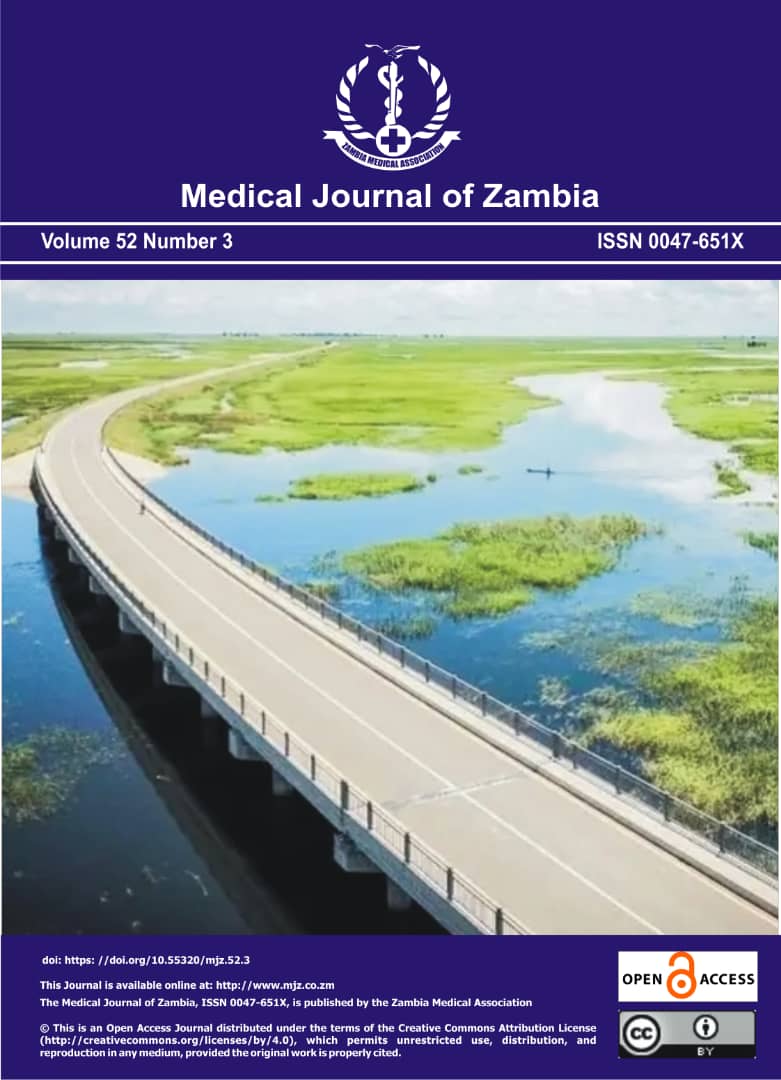Trends and Prevalence of Rifampicin-Resistant Tuberculosis at Ndola Teaching Hospital, Zambia (2020–2022)
DOI:
https://doi.org/10.55320/mjz.52.3.650Keywords:
Mycobacterium tuberculosis, drug-resistance, rifampicin, Ndola, ZambiaAbstract
Background: Rifampicin resistance tuberculosis (TB) is a major public health problem in Zambia. It is associated with Multidrug-resistant TB, caused by Mycobacterium tuberculosis strains resistant to at least rifampicin, one of the most potent first-line anti-TB drugs. Rifampicin resistance (RR) TB represents a significant threat to TB control efforts, complicating treatment by necessitating longer, more toxic, and costly regimens with poorer outcomes. This poses considerable challenges for both diagnosis and treatment, further straining Zambia's healthcare system. The study aimed to determine the trends and prevalence of rifampicin-resistant Tuberculosis at Ndola Teaching Hospital, Zambia (2020–2022).
Method: A laboratory-based, retrospective, cross-sectional study was conducted at Ndola Teaching Hospital, spanning a three-year period from January 2020 to December 2022. The study included all patients with clinically suspected TB whose sputum samples were tested using the GeneXpert MTB/RIF assay. The sample size was calculated using Cochran's formula, based on an estimated RR-TB prevalence of 5.9%, resulting in a minimum required sample size of 2,133 participants. Sputum samples were processed using the GeneXpert MTB/RIF assay, which detects Mycobacterium tuberculosis and RR through real-time polymerase chain reaction. Ethical approval was granted by the University of Zambia School of Medicine Undergraduate Research Ethics Committee and the National Health Research Authority. Descriptive statistics were employed, and data analysis was carried out using the Statistical Package for Social Sciences (SPSS) version 22.
Results: The study found an overall TB prevalence of 12% (95% CI: 11.15%–12.86%) among 5,590 participants, with RR-TB detected in 2.98% of cases. RR-TB prevalence was highest among males and the 18–34 age group 60% (95% CI: 38.66%–78.12%). RR-TB prevalence increased significantly from 1.53% (95% CI: -0.19–3.20) in 2020 to 3.13% (95% CI: 0.84–5.36) in 2021 and 4.6% (95% CI: 1.89–7.05) in 2022, contrasting with the stable trend in overall TB prevalence 11.41% (95% CI: 9.92–12.90) in 2020, 11.96% (95% CI: 10.50–13.43) in 2021, and 12.57% (95% CI: 11.10–14.04) in 2022. HIV/TB co-infection was observed in 36.8% of participants, highlighting the ongoing burden of dual infection.
Conclusion: This study highlights the growing burden of RR-TB, despite stable overall TB rates. The increase in RR-TB, particularly among males and young adults, underscores the urgent need for enhanced diagnostic capacity, including widespread use of rapid molecular tests like GeneXpert, and targeted interventions for high-risk groups. Integrated HIV/TB care and improved access to second-line treatments are critical to address the clinical implications of rising RR-TB, which complicates treatment and increases healthcare costs.
Downloads
Downloads
Published
Issue
Section
License
Copyright (c) 2025 Medical Journal of Zambia

This work is licensed under a Creative Commons Attribution-NonCommercial 4.0 International License.









